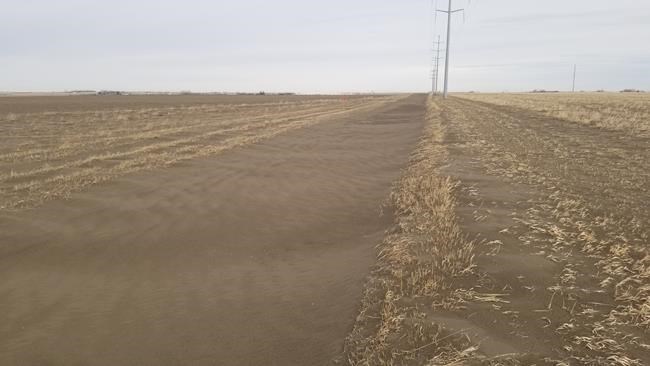CALGARY — Nearly a century after the mass agricultural disaster known as the Dirty '30s, drought conditions on the Prairies are once again raising the risk that farmers' valuable topsoil will go blowing in the wind.
Across southern Alberta, severe erosion events have been increasing in frequency and severity in recent years. In Lethbridge County, dry and windy conditions have been known to stir up dust clouds, obscuring the vision of drivers on local roads and filling irrigation canals to the brim with dirt.
The drifting soil also reduces agricultural productivity, both by removing nutrients from the field where it blows from, and by spreading weeds and damaging crops where it lands.
"It's pretty obvious when land blows. It fills the ditches; there's literally drifts of soil," said Ken Coles, executive director of the non-profit Farming Smarter.
Coles, who also has a farm in the Lethbridge area, got a first-hand taste of it a few years ago when strong winds picked up the top layer of a neighbours' field that had been weakened by drought and recent tilling, depositing more than two feet of soil onto his own land.
"If you have a vulnerable field, as soon as particles of soil start moving, there's a chain reaction. The next thing you know you've got the whole field moving," Coles said.
"It's a very extreme example of aerial soil erosion, something we saw much more in the '30s. But it is still happening."
During the 1930s, drought conditions and poor farming practices coalesced to set the stage for brutal dust storms across much of North America's agricultural regions.
These storms were capable of turning the sky black in the middle of the day as millions of acres of topsoil were lifted into the sky, destroying crops and harming livestock.
The agriculture industry learned many lessons from that disaster, including the importance of farming practices in soil conservation.
Minimizing the tilling of soil, for example, has been proven to greatly reduce the risk of erosion and has been widely embraced by modern farmers.
But while a repeat on the scale of the Dirty '30s is unlikely, recent climate and weather conditions on the Prairies have primed the soil to blow.
"We’re definitely going through a drought cycle. One of the things we’ve noticed as far as our local climate in southern Alberta is that our winters are getting warmer, and I also think our winds are getting stronger," Coles said.
“With those two combinations, I do think there’s been an increased severity and risk of wind erosion.”
Currently, 81 per cent of Canada's agricultural landscape is classified as either abnormally dry or in moderate-to-severe drought conditions, according to federal government mapping.
When drought causes crops to fail, there isn't enough residual plant life leftover on fields in the early spring to hold down the topsoil, said Henry Chau, a Lethbridge-based research scientist for Agriculture and Agri-Food Canada.
Once the soil does start to blow, it can create a vicious cycle. The top layer of soil on a field is usually the most productive, Chau said, so losing it makes additional crop failures more likely.
Soil loss also makes it harder for the land to absorb the precipitation that does fall, thereby perpetuating the drought cycle.
"The biggest challenge is once you lose it, it's hard for the soil to recover," Chau said.
"Losing a bit of soil on the surface, you might not think it's such a concern, but to replenish it or build up soil over a certain amount of time takes a lot of effort."
Erosion is also expensive. A 2019 study by the European Commission's Joint Research Centre pegged the estimated annual impact of erosion on global GDP at US$8 billion.
Another study, published in 2016 by University of Manitoba researcher David Lobb, concluded that soil loss due to erosion costs the Canadian agriculture industry $2 billion per year in lost productivity.
"There's definitely a cost, and it does have a real impact," said Lethbridge County reeve Tory Campbell, adding local municipalities are often left footing the bill for clean-up when a chunk of farmland blows onto a county road or fills a drainage ditch.
Campbell, who is also a farmer, said county officials are working to raise awareness of soil erosion and ways to manage it.
Cover crops, for example, are crops that can be planted in the fall not for the purpose of harvesting, but to ensure vegetation cover in the spring when the winds start to blow. Strategically timed manure placement can also help to anchor the soil.
"There are steps that can be taken, and I think that's on everyone's mind," Campbell said.
"I think we all acknowledge how valuable that topsoil is to us as producers. And you know, it's just gut-wrenching when you see it blowing away."
This report by The Canadian Press was first published Jan. 22,2024.
Amanda Stephenson, The Canadian Press




